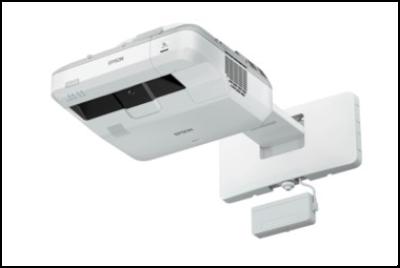Radius Global Market Research Proves Display Size Matters
New Epson EB-710Ui laser ultra-short throw projectors underpin commitment to every student’s right to an equal education
AUCKLAND, 20 June 2017 – Following on from last year’s study Radius Global Market Research have published the results of research that evaluated the readability of content displayed on 70-inch screens in average-sized classrooms. According to the results, more than 50 percent of students in each country surveyed found that contents displayed on 70-inch screens was difficult to read, with more than half of students writing down at least one item incorrectly from a 70-inch screen.

EB-710Ui laser ultra-short throw projector
The study was conducted with students aged 12 to 22 divided into groups of approximately 30. The students were asked to read typical educational content including charts and text-based information displayed on a top-selling 70-inch flat panel in a traditional 8.3 m by 8.4 m classroom, and then write down six short items of information based on what they saw.
The research findings support the “4/6/8 rule” (see more on this below) for display size recommendations. This rule is a long-standing informal guideline commonly used by AV integrators and installers for determining the appropriate sized displays for different environments including classrooms, conference rooms and large venues.
The research findings are revealed as Epson announces its latest generation of ultra-short throw laser projectors designed to enhance the quality of educational learning. The new Epson EB-710Ui laser ultra-short throw projector that will be rolled out worldwide from the end of October can provide better visibility in the classroom for images in large sizes of up to 100 inches. In addition to the large display size, the EB-710Ui boasts 4,000 lm of brightness and WUXGA resolution, which allows it to be used to provide high-level educational content in classrooms around the world. In addition, the EB-710Ui has a laser light source that provides consistent performance and frees customers from lamp replacement concerns.
Epson Australia’s Business Division General Manager Craig Heckenberg said, “When it comes to choosing the best display for your classroom, it is important that it’s large enough so every student in the room can clearly read what’s on it. This is absolutely critical to each student’s success. Designed with educator input, the new EB-710Ui and other Epson advanced interactive display and projector technologies make bright, collaborative learning environments a reality.”
For more information on
display size readability go to:
http://www.epson.com.au/gobigwithepson/
The 4/6/8 rule

In audio visual (AV) installations, the informal guideline used for determining screen size is known as the 4/6/8 rule. This rule establishes that ideal viewing distance, in correlation with room size, should be four, six or eight times the height of the screen for analytical viewing, basic viewing and passive viewing.
The advantage of applying this rule in classrooms is that the distances can be measured according to particular activities needing use of the screen.
Ends


 Athletics New Zealand: Connor Bell Breaks NZ Discus Record (Again)
Athletics New Zealand: Connor Bell Breaks NZ Discus Record (Again) Tertiary Education Union: UCOL Cuts Will Cause Lasting Damage
Tertiary Education Union: UCOL Cuts Will Cause Lasting Damage National Library Of New Zealand: Kate De Goldi Named Te Awhi Rito Reading Ambassador For Aotearoa
National Library Of New Zealand: Kate De Goldi Named Te Awhi Rito Reading Ambassador For Aotearoa Hikoi for Health: Healthcare Crisis Drives Cross-Country Protest | Hīkoi For Health Set To Begin
Hikoi for Health: Healthcare Crisis Drives Cross-Country Protest | Hīkoi For Health Set To Begin University of Auckland: New Zealand Professor's Paper Is One Of Century's Most-Cited
University of Auckland: New Zealand Professor's Paper Is One Of Century's Most-Cited Taite Music Prize: The 2025 Taite Music Prize Winner Is MOKOTRON - WAEREA
Taite Music Prize: The 2025 Taite Music Prize Winner Is MOKOTRON - WAEREA